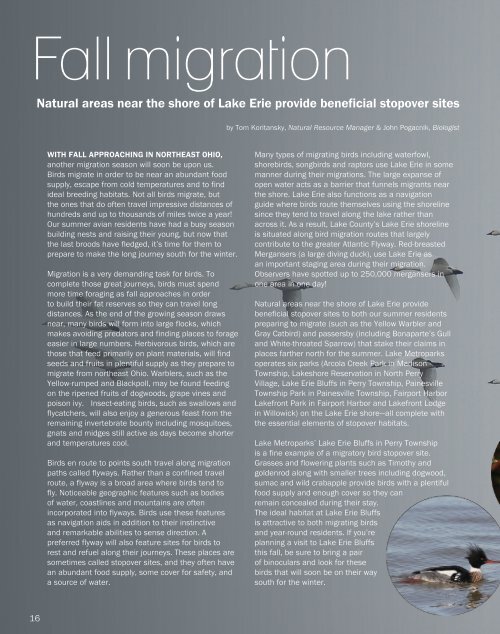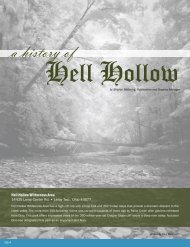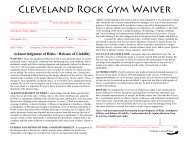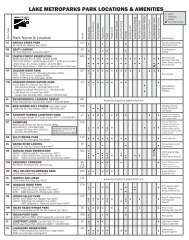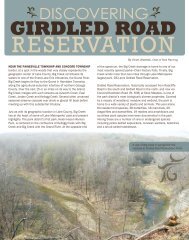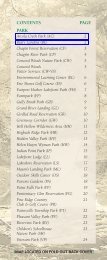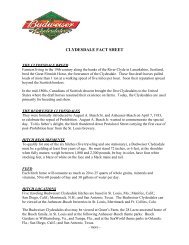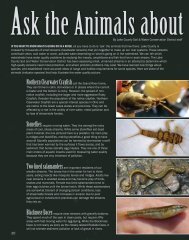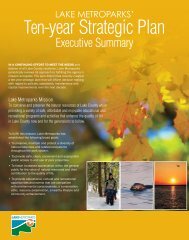Download Parks Plus! Fall 2013 (PDF - Lake Metroparks
Download Parks Plus! Fall 2013 (PDF - Lake Metroparks
Download Parks Plus! Fall 2013 (PDF - Lake Metroparks
You also want an ePaper? Increase the reach of your titles
YUMPU automatically turns print PDFs into web optimized ePapers that Google loves.
<strong>Fall</strong> migration<br />
Natural areas near the shore of <strong>Lake</strong> Erie provide beneficial stopover sites<br />
by Tom Koritansky, Natural Resource Manager & John Pogacnik, Biologist<br />
With fall approaching in northeast Ohio,<br />
another migration season will soon be upon us.<br />
Birds migrate in order to be near an abundant food<br />
supply, escape from cold temperatures and to find<br />
ideal breeding habitats. Not all birds migrate, but<br />
the ones that do often travel impressive distances of<br />
hundreds and up to thousands of miles twice a year!<br />
Our summer avian residents have had a busy season<br />
building nests and raising their young, but now that<br />
the last broods have fledged, it’s time for them to<br />
prepare to make the long journey south for the winter.<br />
Migration is a very demanding task for birds. To<br />
complete those great journeys, birds must spend<br />
more time foraging as fall approaches in order<br />
to build their fat reserves so they can travel long<br />
distances. As the end of the growing season draws<br />
near, many birds will form into large flocks, which<br />
makes avoiding predators and finding places to forage<br />
easier in large numbers. Herbivorous birds, which are<br />
those that feed primarily on plant materials, will find<br />
seeds and fruits in plentiful supply as they prepare to<br />
migrate from northeast Ohio. Warblers, such as the<br />
Yellow-rumped and Blackpoll, may be found feeding<br />
on the ripened fruits of dogwoods, grape vines and<br />
poison ivy. Insect-eating birds, such as swallows and<br />
flycatchers, will also enjoy a generous feast from the<br />
remaining invertebrate bounty including mosquitoes,<br />
gnats and midges still active as days become shorter<br />
and temperatures cool.<br />
Birds en route to points south travel along migration<br />
paths called flyways. Rather than a confined travel<br />
route, a flyway is a broad area where birds tend to<br />
fly. Noticeable geographic features such as bodies<br />
of water, coastlines and mountains are often<br />
incorporated into flyways. Birds use these features<br />
as navigation aids in addition to their instinctive<br />
and remarkable abilities to sense direction. A<br />
preferred flyway will also feature sites for birds to<br />
rest and refuel along their journeys. These places are<br />
sometimes called stopover sites, and they often have<br />
an abundant food supply, some cover for safety, and<br />
a source of water.<br />
Many types of migrating birds including waterfowl,<br />
shorebirds, songbirds and raptors use <strong>Lake</strong> Erie in some<br />
manner during their migrations. The large expanse of<br />
open water acts as a barrier that funnels migrants near<br />
the shore. <strong>Lake</strong> Erie also functions as a navigation<br />
guide where birds route themselves using the shoreline<br />
since they tend to travel along the lake rather than<br />
across it. As a result, <strong>Lake</strong> County’s <strong>Lake</strong> Erie shoreline<br />
is situated along bird migration routes that largely<br />
contribute to the greater Atlantic Flyway. Red-breasted<br />
Mergansers (a large diving duck), use <strong>Lake</strong> Erie as<br />
an important staging area during their migration.<br />
Observers have spotted up to 250,000 mergansers in<br />
one area in one day!<br />
Natural areas near the shore of <strong>Lake</strong> Erie provide<br />
beneficial stopover sites to both our summer residents<br />
preparing to migrate (such as the Yellow Warbler and<br />
Gray Catbird) and passersby (including Bonaparte’s Gull<br />
and White-throated Sparrow) that stake their claims in<br />
places farther north for the summer. <strong>Lake</strong> <strong>Metroparks</strong><br />
operates six parks (Arcola Creek Park in Madison<br />
Township, <strong>Lake</strong>shore Reservation in North Perry<br />
Village, <strong>Lake</strong> Erie Bluffs in Perry Township, Painesville<br />
Township Park in Painesville Township, Fairport Harbor<br />
<strong>Lake</strong>front Park in Fairport Harbor and <strong>Lake</strong>front Lodge<br />
in Willowick) on the <strong>Lake</strong> Erie shore—all complete with<br />
the essential elements of stopover habitats.<br />
<strong>Lake</strong> <strong>Metroparks</strong>’ <strong>Lake</strong> Erie Bluffs in Perry Township<br />
is a fine example of a migratory bird stopover site.<br />
Grasses and flowering plants such as Timothy and<br />
goldenrod along with smaller trees including dogwood,<br />
sumac and wild crabapple provide birds with a plentiful<br />
food supply and enough cover so they can<br />
remain concealed during their stay.<br />
The ideal habitat at <strong>Lake</strong> Erie Bluffs<br />
is attractive to both migrating birds<br />
and year-round residents. If you’re<br />
planning a visit to <strong>Lake</strong> Erie Bluffs<br />
this fall, be sure to bring a pair<br />
of binoculars and look for these<br />
birds that will soon be on their way<br />
south for the winter.<br />
16


